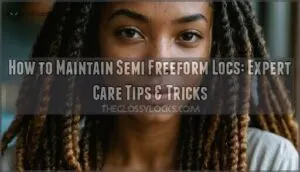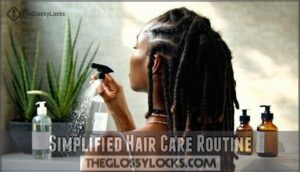This site is supported by our readers. We may earn a commission, at no cost to you, if you purchase through links.
 You can maintain semi freeform locs by keeping things simple and letting your hair lead the way.
You can maintain semi freeform locs by keeping things simple and letting your hair lead the way.
Wash your locs regularly with clarifying shampoo to prevent buildup, but skip the frequent retwisting that traditional locs demand.
Instead, focus on moisture with lightweight oils and protect your locs at night with a satin scarf or bonnet.
The beauty lies in embracing the natural variations in size and texture that develop over time, and don’t overthink it – your locs will thicken and mature naturally when you give them space to breathe.
There’s more to mastering this balanced approach than meets the eye.
Table Of Contents
- Key Takeaways
- What Are Semi-Freeform Locs?
- Simplified Hair Care Routine
- Protect Your Locs at Night
- Retwisting and Thinning Awareness
- Styling Versatility and Creative Freedom
- Transitioning to Semi-Freeform Locs
- Maintaining Cleanliness and Softness
- Embracing Changes and Growth
- Frequently Asked Questions (FAQs)
- How do you take care of freeform locs?
- How often should I retwist semi-freeform locs?
- How do you maintain freeform dreads?
- How to protect freeform dreads?
- How to maintain semi-freeform LOCS?
- Are semi-freeform LOCS right for You?
- How often should you retwist a semi-freeform Loc?
- Should I Freeform my LOCS?
- How do you care for Freeform LOCS?
- Can semi-freeform locs work for all hair types?
- Conclusion
Key Takeaways
- Wash your locs regularly with clarifying shampoo to prevent buildup and keep your scalp healthy.
- Keep your locs moisturized with lightweight oils and protect them at night using a satin scarf or bonnet.
- Separate your roots every few weeks to prevent fusion and maintain individual loc structure.
- Retwist every 4-6 months for balance between natural growth and minimal maintenance.
What Are Semi-Freeform Locs?
Semi-freeform locs combine the natural growth of freeform locs with occasional maintenance like root separation and light retwisting.
You’ll get a structured yet organic look that requires minimal upkeep while maintaining your hair’s natural texture and movement.
Benefits of Semi-Freeform Locs
Semi-freeform locs deliver several game-changing benefits that transform your hair journey.
You’ll discover a natural aesthetic that celebrates your unique texture while enjoying incredible styling options.
Your scalp health improves with less manipulation, and you’ll save money with this cost-effective approach to loc maintenance.
- Low Maintenance Freedom: Semifreeform locs require minimal daily upkeep, giving you more time for life’s adventures
- Natural Hair Expression: Your locs develop organically, showcasing your hair’s authentic character and growth patterns
- Versatile Loc Care: Easy styling flexibility lets you switch between structured and free-flowing looks effortlessly
Differences Between Semi-Freeform and Traditional Locs
Traditional dreadlocks demand strict maintenance frequency with retwisting every 4-6 weeks, while semi freeform locs require attention only every 4-6 months.
Your styling options expand dramatically with semifreeform—you’re not locked into rigid patterns.
The root structure develops more naturally, creating organic variations instead of cookie-cutter uniformity.
Formation methods differ too: traditional locs follow structured techniques, but maintaining locs in semifreeform style means embracing your hair’s natural tendencies.
Freeform dreads represent total freedom, while semifreeform strikes the perfect balance between structure and spontaneity.
Embracing Individual Loc Uniqueness
Unlike traditional locs that follow strict rules, your semi freeform locs are meant to be wildly different from each other.
Your locs don’t need permission to be beautifully imperfect—let them rebel against uniformity and celebrate their wild, authentic differences.
Each loc develops its own personality, thickness, and texture – that’s the magic. You’re not aiming for perfection; you’re celebrating texture and unique growth patterns that make your natural hair journey authentic.
Your loc care routine should honor these individual differences:
- Thick locs next to thin ones – creating visual interest and natural dimension
- Varying textures – some smooth, others fuzzy, all beautifully imperfect
- Natural accessories – wooden beads or shells that complement your organic style
- Social media styling inspiration – showcasing your unique loc maintenance approach
This hair health philosophy embraces beautiful chaos.
Simplified Hair Care Routine
You’ll find that maintaining semi-freeform locs doesn’t require complex routines or expensive products.
The key is focusing on three essential practices: limiting how much you handle your locs, keeping them moisturized, and washing them regularly to prevent buildup.
Limiting Manipulation for Loc Health
Your semi freeform locs thrive when you keep your hands off them. Think of it like tending a wild garden – the less you mess with it, the better it grows.
Gentle styling is your best friend here. Skip tight ponytails, headbands, and constant touching that leads to root thinning. Your locs need breathing room to develop their natural character without stress.
Preventing breakage starts with minimal tension during any loc manipulation. When you do handle them for washing or loc separation, move slowly and deliberately. This hands-off approach promotes healthy regrowth and keeps your loc maintenance routine simple.
Strong roots equal beautiful locs that last.
Prioritizing Moisture in Loc Care
Keeping your semi freeform locs properly hydrated prevents loc dry conditions and maintains healthy hair growth.
Your locs need consistent moisture to thrive, especially when climate impact affects your hair’s natural oils.
Smart hydration methods make all the difference:
- Daily light oil application – Choose lightweight natural oils that won’t cause product buildup
- Weekly water-based moisturizers – Target scalp health with residue-free formulas
- Monthly deep conditioning – Essential loc moisturizing treatment for deep hydration
Your oil selection matters more than you think.
Heavy oils create buildup, while lighter options penetrate effectively.
Loc hydration isn’t complicated when you stick to proven methods.
Monitor how your hair responds to different moisture levels and adjust accordingly for ideal results.
Regular Shampooing and Buildup Removal
Washing your semi freeform locs weekly prevents stubborn buildup that weighs down your hair. Shampoo frequency matters—focus on your scalp during each wash to maintain scalp health.
Use clarifying shampoos monthly to tackle product residue effectively. This loc cleaning routine keeps your locs fresh and prevents loc buildup from stealing your hair’s natural beauty and movement.
Protect Your Locs at Night
Your semi-freeform locs need protection while you sleep to prevent friction damage and moisture loss.
Using a satin scarf, bonnet, or pillowcase creates a smooth barrier that keeps your locs healthy and reduces frizz overnight.
Importance of Nighttime Protection
Your hair fights an invisible battle every night against cotton sheets and rough pillowcases.
Your locs deserve better than rough cotton—they’re fighting for their life while you sleep.
Friction steals moisture and creates frizz while you sleep.
Satin benefits your locs by reducing harmful rubbing that leads to breakage. A satin scarf or bonnet becomes your loc’s nighttime armor, preserving your hairstyle while you rest.
This simple loc protection method prevents lint from embedding in your strands and maintains moisture retention.
Without proper nighttime care, you’ll wake up with tangled, dry locs that need extra styling time.
Using Satin Scarf or Bonnet
Now that you understand why nighttime protection matters, let’s talk about your satin scarf or bonnet—your semi freeform locs’ ultimate shield. Satin material works like magic, creating a smooth surface that prevents friction and keeps your locs happy while you sleep.
Choose a bonnet with proper bonnet tightness—snug enough to stay put but loose enough to breathe. Focus on edge protection by ensuring your hairline stays covered. This simple step boosts moisture retention and stops lint prevention from becoming a daily battle.
Many people are now using satin scarf locs for sleeping and daytime activities.
Ditch that cotton pillowcase for good. Your loc protection game just leveled up with this one change. A quality satin scarf wrapped around your head works just as well as any bonnet, giving you options that fit your style and comfort needs.
Retwisting and Thinning Awareness
You’ll need to retwist your semi-freeform locs every 4 to 6 months to maintain their shape and keep your roots strong.
Watch your locs carefully for signs of thinning, and adjust your care routine if you notice your roots getting weaker or breaking.
Frequency of Retwisting
Your retwist schedule can make or break your semi freeform locs journey. Most locticians recommend spacing retwists 4-12 weeks apart, but your hair texture and growth stage determine the sweet spot.
- Starter phase: Retwist every 2-3 weeks initially
- Budding phase: Stretch to 8-12 weeks between sessions
- Mature locs: Every 4-6 months works perfectly
- Product buildup: Wait 6+ weeks to minimize residue
- Root strength: Longer intervals prevent thinning damage
Finding your rhythm takes patience, but retwist benefits include healthier roots and stronger locs that’ll thank you later. Selecting the right products for retwisting is also an important consideration.
Monitoring for Thinning and Adjusting Regimen
Vigilance becomes your best friend when maintaining semi-freeform locs. Root observation should happen after every retwist—look for signs of hair thinning or hair damage along your scalp and loc length.
Understanding thinning causes helps you spot trouble before it spreads. When you notice weak spots, it’s time for regimen adjustments.
Switch to gentler loc moisture routines, reduce manipulation, and evaluate your current products. Product evaluation might reveal heavy creams causing buildup or harsh shampoos stripping natural oils.
Don’t hesitate to seek professional consultation when loc thinning persists despite your best efforts. Your loc regimen should evolve with your hair’s changing needs, keeping those beautiful locs strong and healthy for years ahead.
Styling Versatility and Creative Freedom
You’ll discover that semi-freeform locs offer endless creative possibilities, from embracing natural frizz to showcasing your locs’ unique thickness and texture.
This styling approach gives you the freedom to express your personality while maintaining healthy, beautiful locs that grow naturally with minimal interference, allowing for beautiful locs to flourish.
Embracing Frizz and Fuzzy Roots
Celebrate frizz as your semi freeform locs’ natural crown of glory.
Your loc roots tell a story of authentic growth that can’t be replicated in any salon chair.
This natural aesthetic becomes your signature style when you stop fighting against your hair’s unique texture and start working with it.
- Root texture variations create visual interest and depth in your overall look
- Effortless style emerges when you let your locs breathe and move naturally
- Unique growth patterns showcase your hair’s individual personality and character
- Frizz acceptance transforms loc maintenance from a chore into self-celebration
Showcasing Thicker Freeform Locs
Your semi freeform locs have blossomed into magnificent, thick masterpieces that deserve to shine. Embrace Texture and Celebrate Growth as your locs develop their own Unique Patterns and Loc Fullness.
The natural hair growth process creates incredible loc volume and loc thickness that tells your personal story.
| Styling Approach | Texture Focus | Volume Benefits |
|---|---|---|
| Minimal Touch-Ups | Natural Frizz | Enhanced Fullness |
| Root Freedom | Organic Patterns | Increased Density |
| Growth Celebration | Authentic Texture | Bold Statement |
| Creative Expression | Individual Character | Personal Style |
| Volume Styling | Embrace Thickness | Natural Growth |
Let your thicker locs speak volumes about your journey toward authentic self-expression and freedom.
Access to Holistic Locs Planner
Documentation becomes your secret weapon when maintaining semi freeform locs.
A Holistic Locs Planner transforms your loc maintenance journey into organized progress tracking:
- Progress Tracking – Monthly photo documentation
- Root separation reminders for healthy growth
- Shampooing schedule optimization
- Styling Inspiration collection and experimentation
- Community Sharing connections with fellow loc enthusiasts
This planner’s features deliver holistic benefits, helping you master your routine while keeping that protective satin scarf handy.
Transitioning to Semi-Freeform Locs
Making the switch to semi-freeform locs means you’ll reduce your maintenance routine while keeping some structure at your roots.
You can move from traditional locs by spacing out your retwist sessions to every 4-6 months, or start fresh using starter locs, twist methods, or the neglect approach.
Choosing to Transition to Semi-Freeform
Your loc journey’s transformation starts with understanding why you want change.
Evolving to semi freeform locs requires honest hair assessment and realistic expectations about the process.
Consider these evolution reasons before making the switch:
- Reduce time spent on frequent loc retwisting sessions
- Embrace your hair’s natural growth patterns and texture
- Simplify your loc maintenance routine substantially
- Allow more organic root separation between appointments
- Experience the freedom that freeform dreads offer
Patience needed—this lifestyle fit isn’t instant, as it requires realistic expectations and an understanding of the natural growth patterns of your hair.
Starting Method Options
Your hair’s journey toward semi freeform dreads begins with choosing the right foundation method. Starter locs offer eight distinct approaches, including braid locs, comb coils, and various twisting techniques. These methods give you control over initial size and pattern through strategic hair parting before shifting to freeform maintenance.
The neglect method takes a hands-off approach, letting your natural texture guide loc formation through regular washing alone. This creates varying sizes and organic patterns that embrace your hair’s unique character.
Locking techniques like interlocking or backcombing provide structure during the baby stage, then you can shift to minimal maintenance once your locs mature. Many people combine methods—starting with twists or braids, then semi-freeforming after a few months.
Root separation becomes your main maintenance tool, preventing locs from marrying while preserving that natural, effortless look you’re after.
Maintaining Cleanliness and Softness
Your semi-freeform locs need consistent care to stay healthy and soft, not the "set it and forget it" approach many people think works.
You’ll maintain clean, beautiful locs by washing regularly with residue-free shampoo and using simple, essential products that won’t build up over time, which helps in maintain clean locs.
Rejecting Neglect in Loc Care
Maintaining healthy locs isn’t rocket science, but it does require dedication. You can’t just set and forget your semi freeform locs. Consistent washing and gentle handling prevent breakage while keeping your crown magnificent.
Regular inspection catches problems early, saving you heartache later. Follow these essential loc maintenance steps:
- Consistent Washing – Cleanse weekly with clarifying shampoo
- Root Hydration – Apply lightweight moisturizers regularly
- Gentle Handling – Use microfiber towels for drying
- Prevent Breakage – Separate roots carefully every few weeks
- Regular Inspection – Check for thinning or damage signs
Quality loc care means showing up consistently. Using the right product matters for loc health.
Simplifying Routine With Essential Products
Skip the product overload and keep your loc maintenance simple with just a few key essentials. Residue-free shampoos form the backbone of healthy hair care, preventing buildup that can suffocate your locs.
When shampooing, focus on your scalp rather than scrubbing the locs themselves.
For natural oils, stick to lightweight options like jojoba or sweet almond oil. Heavy products weigh down your hair and disrupt the natural locking process.
Your moisturizing frequency should match your scalp’s needs—typically every 2-3 days with a simple water and oil spray.
Product application matters more than quantity. Less is more when maintaining scalp health. Mist your roots lightly, then gently separate them to prevent fusion.
This streamlined approach to loc maintenance lets your hair develop naturally without interference. Your locs will thank you for keeping things uncomplicated.
Embracing Changes and Growth
You’ll notice your semi-freeform locs gradually thicken and develop different sizes as they mature naturally.
This growth process creates increased volume and fullness, transforming your locs into a unique pattern that reflects your hair’s natural texture and movement.
Gradual Thickening and Varying Loc Sizes
When you choose semi freeform locs, you’re signing up for a beautiful journey of transformation.
Your locs will gradually thicken and develop their own personality, creating a crown that’s uniquely yours.
Embrace Variation as your natural process unfolds—some locs might grow thicker faster while others take their time.
Here’s what to expect during this exciting phase:
- Unique Textures emerge as each loc develops its own character and density
- Loc Fullness increases naturally without forced manipulation or excessive grooming
- Thickness Benefits become apparent as your locs gain weight and presence
- Styling Thicker locs opens up new creative possibilities for your look
Remember, loc maintenance during this phase means gentle hair separation to limit root marriage.
Your patience will be rewarded with gorgeous, voluminous locs that tell your personal story through their organic growth patterns.
Increased Volume and Fullness
Volume becomes your hair’s signature move as semi-freeform locs mature.
You’ll notice dramatic texture enhancement and natural density building over months. Root thickness creates that coveted fullness you’ve been waiting for.
Embrace loc frizz as part of your growth celebration—it adds authentic character. Regular hair separation prevents loc parts from merging while maintaining individual volume.
Don’t fight the process; your locs are designing themselves. Gentle air-drying and minimal manipulation support volume maintenance naturally.
Watch your rebellion unfold as each loc develops its own personality, creating the thick, textured crown you deserve.
Frequently Asked Questions (FAQs)
How do you take care of freeform locs?
Roughly 70% of freeform loc wearers neglect proper washing, causing buildup. You’ll need regular shampooing every 2-3 weeks, root separation to prevent matting, and daily light oil application for moisture retention.
How often should I retwist semi-freeform locs?
You should retwist your semi-freeform locs every 4 to 6 months.
This timeframe maintains their shape and root strength without over-manipulating them.
Less frequent retwisting preserves the natural, organic look you’re going for.
How do you maintain freeform dreads?
Wash your freeform dreads regularly with clarifying shampoo to prevent buildup.
Separate roots weekly to avoid matting.
Moisturize with light oils, protect with satin scarves, and embrace the natural, organic growth process.
How to protect freeform dreads?
You’re absolutely protecting your crown.
Use satin bonnets nightly, wash regularly with clarifying shampoo.
Separate roots weekly to prevent fusion, and shield with scarves during activities.
Your locs need consistent care, not neglect.
How to maintain semi-freeform LOCS?
Separate your roots every few weeks to prevent fusion. You’ll want to wash regularly with clarifying shampoo, moisturize with light oils, and retwist every 4-6 months for structure.
Are semi-freeform LOCS right for You?
Semi-freeform locs suit you if you want natural growth with minimal upkeep.
They’re perfect for busy lifestyles, offering structured roots while embracing organic texture.
Consider your patience level and desired aesthetic before committing.
How often should you retwist a semi-freeform Loc?
Like watching grass grow, patience pays off with semi-freeform locs.
You’ll want to retwist every four to six months, giving your roots time to strengthen while maintaining that perfect balance between structure and natural flow.
Should I Freeform my LOCS?
Consider your lifestyle and hair goals before freeforming your locs.
If you love natural texture and don’t mind thicker, fuzzier locs, go for it.
However, avoid freeforming if you prefer neat, uniform appearances.
How do you care for Freeform LOCS?
Wash your freeform locs regularly with clarifying shampoo to prevent buildup.
Separate roots weekly to avoid fusion.
Moisturize with light oils, protect with satin scarves, and embrace the natural frizz that defines this carefree style, which is all about maintaining a natural look.
Can semi-freeform locs work for all hair types?
Yes, you can rock semi-freeform locs with most hair textures.
They’re particularly great for coarse, curly hair but work well with fine hair too.
Your natural texture will shine through this low-maintenance, DIY-friendly style beautifully, and with semi-freeform locs, you can achieve a unique look.
Conclusion
Mastering how to maintain semi freeform locs comes down to three key principles: washing regularly, moisturizing consistently, and protecting nightly.
You’ll find that less manipulation leads to healthier growth, while your locs develop their own unique character over time.
Remember to use clarifying shampoo, apply lightweight oils, and sleep with satin protection.
Trust the process, embrace the variations, and let your locs thicken naturally.
Your patience will reward you with beautiful, healthy semi freeform locs.
- https://www.reddit.com/r/locs/comments/17pg6vd/maintenance_on_semi_freeforms/
- https://www.quora.com/What-is-a-great-haircare-routine-for-semi-free-form-dreadlocks
- https://digitalloctician.com/how-to-semi-freeform-locs/
- https://www.youtube.com/shorts/PGHDKA3fQkI
- https://www.nappturality.com/forums/threads/128497-Semi-freeforming













